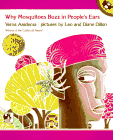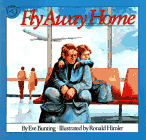Picture Books in the History Program
This article by Carol Otis Hurst first appeared in Teaching K-8 Magazine.
One of the great lessons of history is that perspective matters. So before I start kids searching out details of battles or other events in the past, I want to play with perspective a bit, using picture books to get my point across that there's more than one way to look at a thing.

1. I'd start with the purely visual perspective play in Zoom by Istvan Banyai (Viking, 1995 ISBN 0670858048. Order Online.). The lesson here is that appearances can be deceiving and that there's always a bigger picture. We start with a rooster's comb and zoom outward to larger and larger perspectives in this fascinating wordless book.
2. Verna Aardema's Why Mosquitoes Buzz in People's Ears very ably illustrated by Leo & Diane Dillon (Dial, 1975 ISBN 0803760892. Order Online) is next on my list for history books for several reasons. For one thing, it shows how a simple misunderstanding can escalate into a tragic event. Secondly, we see the perception and the truth at the same time and the difference is great. Thirdly, it's a pourquoi tale that attempts to explain why something happened. When we are tempted to fix blame in history, we could well keep these thoughts in mind. More Information.
3. My other perspective book choice for history is Black & White by David Macaulay (Houghton, 1990 ISBN 0395521513. Order Online). This mind-bending book tells four stories simultaneously. The stories appear at first to be disconnected. At various points the stories seem to share elements and then action and the lines between the stories eventually collapse. I want my students of history to remember that other things are happening in various places around the world besides the events we are focusing on. Yet, nothing occurs in a vacuum. Those other events matter. I also want them to keep in mind that each of the characters, with the possible exception of the cows in this book, would have a different viewpoint on what happened. More Information and Activities.
4. Moving away now from perspective as such, Byrd Baylor's The Best Town in the World illustrated by Ronald Himler (Simon & Schuster, 1983 ISBN 0684180359. Order Online) is next on my history list. Based on memories of her father, Baylor tells of the small Texas town in which her father grew up. It's a Utopian society with perfection at every turn. Baylor is too skilled a writer to make the point too obvious but most readers will readily understand that nostalgia paints with a gauzy brush. Before my students go off to interview people or read first hand accounts based on memories of historic events, I want them to realize that memory can exaggerate.
5. Culture conflict is another thing I want my students to keep in mind when researching historic events. There are many excellent books that approach this idea directly and historically but I'd go first to Old Henry by Joan W. Blos with illustrations by Stephen Gammell (Morrow, 1987 ISBN 0688099351. Order Online). Old Henry moves into a new neighborhood with one set of expectations. His neighbors welcome him but have their own mindset. The clash between the two makes Henry leave. When neither side is happy with his departure, a compromise is proposed. Sounds like history to me.

6. David Bouchard and Henry Ripplinger's If You're Not From the Prairie (Grasshopper Books, 1995 ISBN 1895714664. Order Online) drives home another point I want to make with history students. This beautiful book extols the elements as experienced by those who live on the vast plains. It lyrically makes the point that, if you want to know a person, you must find a way to see some of what he sees, feels and thinks. Coming to a historical figure and attempting to explain his or her life is almost impossible unless you know these things at least.
7. Fly Away Home by Eve Bunting with illustrations by Ronald Himler (Clarion, 1991 ISBN 0395559626. Order Online) is next on my history list because it zeroes in on the homeless and disenfranchised. This boy and his father must live in an airport, not because the father cannot find work but because he's part of the working poor and they cannot afford a home. There may well be good times economically in our present and our past but the wealth doesn't get to everybody. I'd like students to remember that. More Information and Activities.
8. Lynne Cherry's A River Ran Wild: An Environmental History (Harcourt Brace, 1992 ISBN 0152005420. Order Online) comes next. Here we see how human beings have used and abused natural resources by focusing on events on one river through time. The idea that most actions, even beneficent ones, have results and reactions, some of which may be detrimental certainly has historical applications beyond this book. More Information.

9. Barbara Cooney's Miss Rumphius (Puffin, 1985 ISBN 0140505393. Order Online) is my next choice. Having goals and attaining them is, in itself, a valuable lesson, historical or otherwise but the idea that each person should leave the world more beautiful is a lovely way of approaching the value of famous lives to those who came after. More Information.
10. We'll end the historical section of this column with another pourquoi tale: The Magpies' Nest by Joanna Foster and Julie Downing (Clarion, 1995 ISBN 0395621550. Order Online). The story explains why different birds build vastly different nests. They were all learning from the same teacher, the magpie, who was known for nest-building perfection. Unfortunately, or fortunately if diversity is the aim, birds stay only long enough to take in one step of her meticulous efforts before rushing off to build their own nests. It isn't too big a step from this book to learning to get the whole picture before dashing.
Related Areas of Carol Hurst's Children's Literature Site
- In Times Past: An Encyclopedia for Integrating US History with Literature in Grades 3-8 by Carol Hurst and Rebecca Otis.
- US History and Children's Literture. Books, articles and activities.
- World History and Children's Literature. Books, articles and activities.
- Looking Critically at Picture Books with Older Readers.
For Your Convenience You Can Order the Following Books Online
You Can Always Change Your Mind Later.
- Zoom
- Why Mosquitoes Buzz in People's Ears
- Black & White
- The Best Town in the World
- Old Henry
- If You're Not From the Prairie
- Fly Away Home
- A River Ran Wild: An Environmental History
- Miss Rumphius
- The Magpies' Nest).
- In Times Past: An Encyclopedia for Integrating US History with Literature in Grades 3-8
Read More about our agreement with Amazon.com.
Next Section, Math in Picture Books, of November 2000 newsletter
Advertisement:
Advertisement:
Advertisement:

